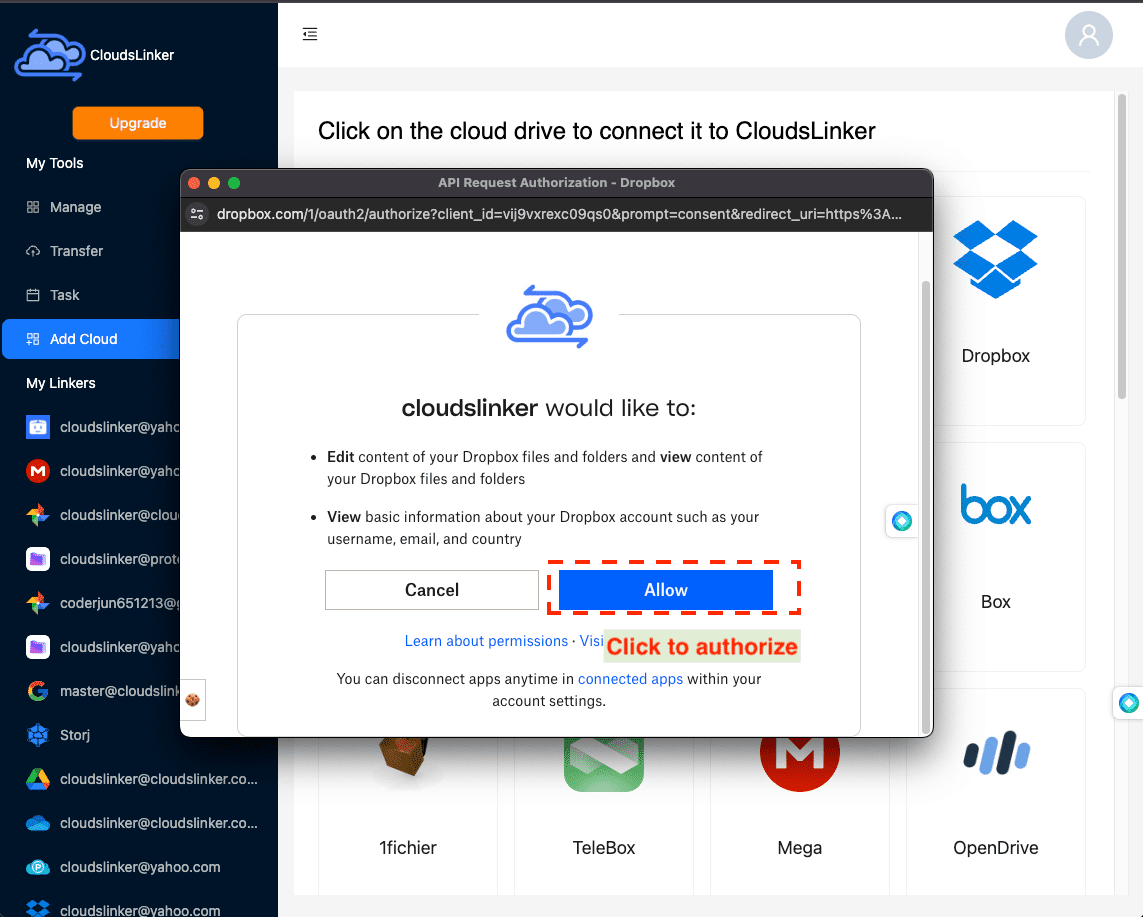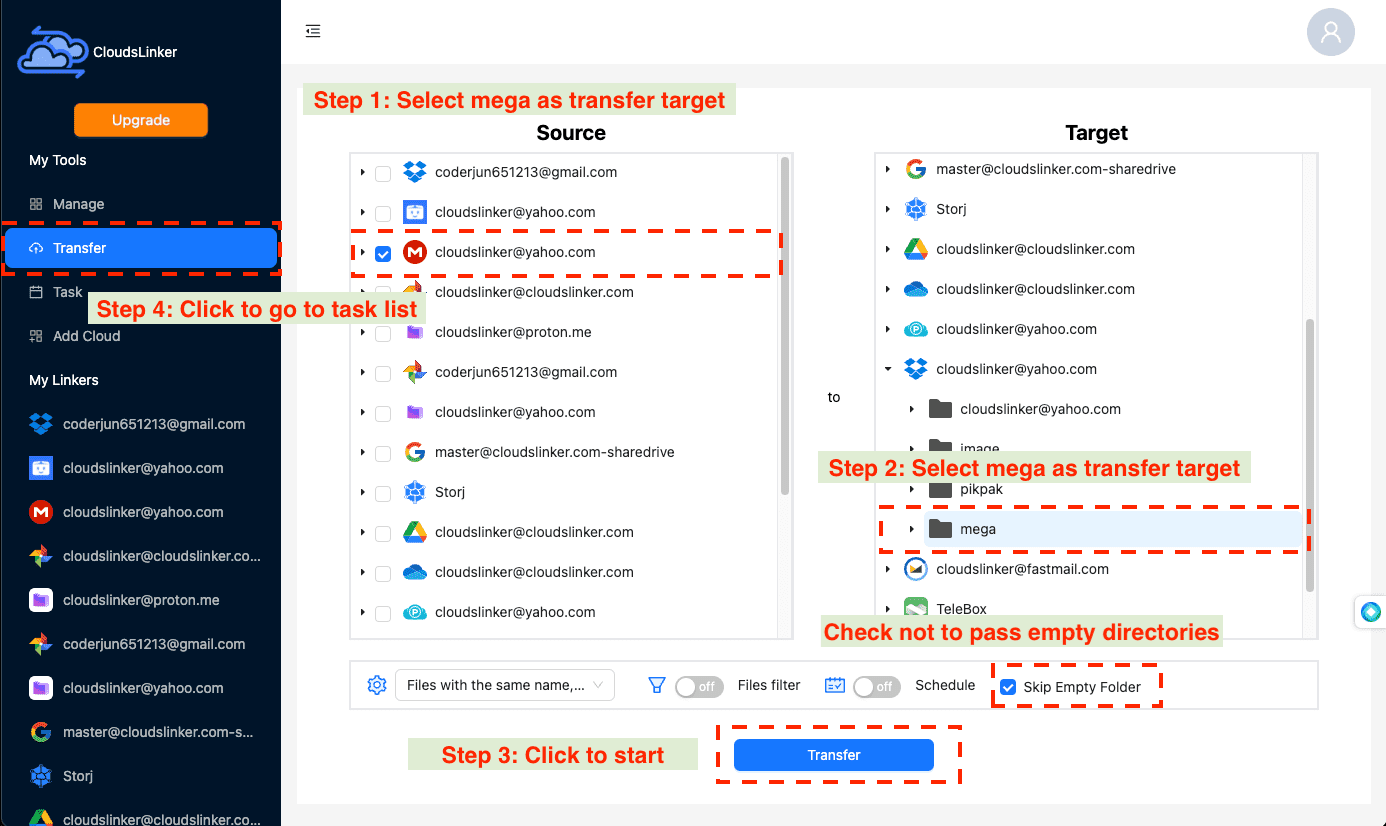Mega to Dropbox Transfer: Streamline Your Cloud Storage Solutions
Discover how to seamlessly transfer your files from Mega to Dropbox. This guide covers everything from preparation, methods, and tips to ensure a smooth migration.
Introduction
In today's digital age, cloud storage has become an indispensable tool for managing our files and data online. Two of the most popular cloud storage services are Mega and Dropbox, each offering unique features and benefits. However, there may come a time when you need to transfer your data from Mega to Dropbox, whether for enhanced collaboration features, superior syncing capabilities, or simply a personal preference for Dropbox's interface. This comprehensive guide aims to simplify the process, providing you with a step-by-step approach to transferring your files from Mega to Dropbox efficiently.
Quick Navigation
Mega is a cloud storage and file hosting service known for its strong emphasis on security and privacy. It offers end-to-end encryption for all data stored on its platform, ensuring that your files remain private and secure.
Dropbox is a leading cloud storage service that excels in file synchronization, sharing, and collaborative workspaces. It is renowned for its ease of use, reliability, and integration with numerous third-party applications.
The main difference lies in their approach to security and collaboration. While Mega focuses on encryption and privacy, Dropbox emphasizes collaboration and integration capabilities.
Switching from Mega to Dropbox provides several advantages, particularly in areas of collaboration and user experience:
- Enhanced Collaboration: While Mega offers robust security through end-to-end encryption, this feature makes it less suitable for collaboration. Dropbox, known for its ease of integration with third-party apps, offers a more collaborative workspace, thus facilitating teamwork and project management.
- Better User Experience: Dropbox's user interface and customer support are considered superior by many users, providing a smoother and more intuitive experience in managing files and folders.
- Legal and Privacy Considerations: Mega, governed by New Zealand law, includes certain clauses in its Terms of Service and Privacy Policy that may not suit all users, especially concerning data takedown policies and IP address collection. Dropbox, headquartered in the United States, operates under different legal frameworks, which might align better with your privacy and operational requirements.
- Flexible Plans and Storage Options: Although Mega offers a generous amount of free storage, Dropbox provides various pricing plans that might offer better value for businesses and individuals needing more than just storage space, including better file recovery options and extensive third-party app integration.
Mega's emphasis on security and privacy through features like zero-knowledge encryption and secure chat options caters well to users prioritizing these aspects. However, for those requiring more versatile file management and collaboration tools, Dropbox emerges as a preferable option, offering a balance between functionality and security, without compromising on user-friendly features.
Preparation for Transfer
Before initiating the transfer, it's essential to assess the volume of data you plan to move and organize your files accordingly. This preparation step ensures a smoother transition, helping you avoid potential issues such as insufficient storage space on Dropbox.
Methods of Transferring Files
Transferring files from Mega to Dropbox can be executed through three primary methods: direct web transfers, open-source software transfers, and third-party cloud-to-cloud services. Each method offers distinct benefits and follows specific procedures, tailored to accommodate different user preferences and technical requirements. Let's delve into the nuances of each approach to determine the best fit for your file migration needs.
- Direct Web Transfers:
This method involves transferring files directly from Mega to Dropbox via their web interfaces. It's straightforward and doesn't require the installation of additional software, making it ideal for users looking for a quick and easy solution. However, it may be more time-consuming for larger data volumes and depends on your web browser's stability and speed.
- Open-Source Software Transfers:
Utilizing open-source software for file migration provides flexibility and control over the transfer process. This option is well-suited for tech-savvy individuals who prefer a customizable approach. Open-source tools often come with a variety of features that can optimize the transfer, including batch processing and scheduled migrations. However, it requires a certain level of technical knowledge to set up and manage.
- Third-Party Cloud-to-Cloud Transfers:
Services specializing in cloud-to-cloud transfers can automate the migration process, offering a seamless and efficient solution for moving files from Mega to Dropbox. These platforms are designed to handle large volumes of data with ease, providing a hassle-free experience for users without the need for manual intervention. Security, reliability, and speed are key advantages, though it's important to consider service costs and privacy policies.
Direct Web Transfers
The simplest route to migrate files from Mega to Dropbox is by first downloading the necessary files from Mega's web interface or desktop client. After securing the files on your local device, the subsequent action involves uploading them to Dropbox using its web platform or desktop application. This method offers an efficient and straightforward means to relocate your digital content between these cloud services, eliminating the need for any intermediary tools or complex procedures.
Step 1: Access Mega
Start by visiting the official Mega website and signing in. Navigate through your files to identify the ones you intend to move to Dropbox. Use the right-click menu on the selected files or folders to choose the 'Download' option, initiating their transfer to your local device.
Step 2: Ready Your Files
Once the download concludes, find the downloaded files or folders on your device. Unzip or extract these items to ensure they are in a format that Dropbox can recognize for upload. This preparation is vital for a smooth upload process to Dropbox.
Step 3: Initiate Upload to Dropbox
Proceed to the official Dropbox website and log into your account. Locate the area within Dropbox where you wish to store the files. Use the 'Upload' feature found in the interface to select and upload the files you've prepared from your device, effectively transferring them from Mega to Dropbox.

This approach is direct and efficient, perfect for moving files of manageable sizes. It's important to remember, though, that transferring very large files might not be as efficient, and the process could be hampered by long download times or limited local storage space. Furthermore, should your computer shut down during a transfer, it may result in incomplete file migration.
Open-Source Software Transfers Using Rclone
Leveraging Rclone, an esteemed open-source tool, offers a sophisticated method to synchronize your data between Mega and Dropbox. Renowned for its versatility and efficiency, Rclone supports numerous cloud storage platforms, allowing for direct transfers without necessitating intermediary storage. This section guides you through the process of utilizing Rclone for file migration, encompassing installation, configuration, and execution stages.
Step 1: Download Rclone
Initiate by downloading Rclone from the official Rclone website. Select the version compatible with your operating system and follow the installation instructions to set up Rclone on your device.
Step 2: Configure Mega and Dropbox within Rclone
Run the Rclone configuration utility by typing rclone config in
your
command line or terminal. Follow the prompts to add Mega and Dropbox as remote destinations.
This
will involve entering your cloud storage credentials and granting Rclone permission to access
your
accounts.
Step 3: Synchronize Files Using Copy or Move Commands
With both services configured, you can now transfer files from Mega to Dropbox.
Use
the rclone copy command to replicate files from the source to the destination
without
removing them from the source, or rclone move to transfer and remove the files from
the
source. For example, rclone copy mega:/path/to/files dropbox:/path/to/destination
will
start the synchronization process.

Utilizing Rclone for file transfers between Mega and Dropbox streamlines the migration process, bypassing the limitations of manual uploads/downloads. It's particularly advantageous for large datasets or automated sync requirements. Ensure you're comfortable with command-line tools and review Rclone's documentation for advanced features and troubleshooting tips.
Third-Party Cloud-to-Cloud Transfers:CloudsLinker
Introducing Cloudslinker for Seamless Data Migration:
Cloudslinker revolutionizes the way we handle cloud storage, enabling effortless file transfers across more than 30 cloud platforms, including from Mega to Dropbox. This sophisticated platform simplifies cloud-to-cloud transfers, ensuring data security through encryption and optimizing bandwidth usage. Whether for individual files or large data volumes, Cloudslinker offers a straightforward and secure approach to digital organization and synchronization.
Step 1: Starting with Cloudslinker
Begin by creating an account or signing in at Cloudslinker. Integrate your Mega account by authorizing Cloudslinker to manage your files, ensuring a secure connection for the transfer process.

Step 2: Linking Dropbox via OAuth2
To add Dropbox to Cloudslinker, select the Dropbox icon from the dashboard. You'll be redirected to a webpage to grant Cloudslinker access via OAuth2. This step is crucial for Cloudslinker to perform actions within your Dropbox account securely.

Step 3: Setting Up Your File Transfer
With both Mega and Dropbox configured, navigate to the 'Transfer' menu to specify Mega as the source and Dropbox as the destination. Customize your transfer settings to match your requirements, choosing between immediate or scheduled transfers.

Monitoring the Transfer and Confirming Completion
Keep track of your transfer's progress through Cloudslinker's 'Tasks' section. Upon completion, verify the successful migration of your files to Dropbox, ensuring all data has been accurately transferred and is accessible.

Benefits of Using Cloudslinker
- Seamless Integration: Cloudslinker's support for OAuth2 simplifies Dropbox integration, ensuring a secure and straightforward setup.
- Efficient Data Management: Manage and transfer files across multiple cloud platforms effortlessly, without the need for local storage.
- Automated Transfers: Schedule your file migrations to run automatically, saving time and ensuring regular backups.
Cloudslinker stands out for its ease of use, security features, and the ability to handle large-scale data migrations efficiently. It's an excellent choice for those seeking a reliable cloud-to-cloud transfer solution.
Comparing Transfer Methods: Direct, Rclone, and Cloudslinker
| Feature | Direct Web Upload/Download | Rclone Transfer | Cloudslinker Transfer |
|---|---|---|---|
| Setup Ease |
Simple, no additional setup required. |
Requires software installation and command-line knowledge. |
Requires account setup and cloud service authorization via OAuth2. |
| Transfer Speed |
Dependent on local internet speed and file size. |
Optimized for speed, adaptable based on network conditions. |
Optimized for speed, not limited by local internet connection. |
| File Size Limitations |
Limited by local storage for download/upload. |
No practical limit, handles large files efficiently. |
Capable of handling large files without local storage limitations. |
| Bandwidth Usage |
Consumes local bandwidth for both download and upload. |
Can be optimized but still relies on local bandwidth. |
Minimal impact on local bandwidth, as transfer occurs cloud-to-cloud. |
| Continuous Operation |
Requires active local operation, interruptions possible. |
Supports scheduled transfers, reducing need for supervision. |
Runs in the background, enabling continuous operation without supervision. |
| Technical Complexity |
Low, user-friendly for non-technical users. |
Medium to high, best for users comfortable with technical setups. |
Low to medium, straightforward after initial setup. |
Frequently Asked Questions
How can I ensure my data remains secure during the transfer?
Security is paramount with all transfer methods. For direct and Rclone transfers, ensure secure connections. Cloudslinker provides encryption, maintaining data integrity. Verify the security protocols of any tool or service used.
What is the fastest way to transfer files from Mega to Dropbox?
Both Cloudslinker and Rclone efficiently handle large data volumes. Cloudslinker facilitates automated cloud-to-cloud transfers, while Rclone provides quick command-line operations. Choose based on data volume and technical proficiency.
Can I transfer data from Mega to Dropbox without a third-party service?
Yes, direct web transfers enable moving files without third-party services, ideal for users avoiding additional tools. This method may be slower for large files or batches.
What should I do if I encounter errors during the transfer?
Check internet connectivity for direct transfers. For Rclone errors, refer to command-line output and documentation. For Cloudslinker issues, utilize their customer support or FAQ for troubleshooting.
How can I manage my storage space effectively during the migration?
Organize and declutter files before migration. Use Rclone's filtering to manage file selection or Cloudslinker's scheduling to optimize transfer times and efficiency.
Enhancing Cloud Storage Migration: Strategies, Security, and Solutions
Security and Privacy Concerns
When transferring data between Mega and Dropbox, understanding and leveraging each platform's security measures are crucial. Mega offers end-to-end encryption, ensuring your data remains encrypted from the moment it leaves your device until it reaches its destination. Dropbox, while also prioritizing security, focuses on seamless integration with third-party apps, which may require adjusting settings to maintain optimal privacy. It's vital to use secure, encrypted connections during the transfer process and to verify the privacy policies of any intermediary tools, like Cloudslinker, to ensure they align with your security standards.
Troubleshooting Common Issues
Transfer issues can arise due to various factors, including internet connectivity, file size limits, or service downtimes. Common troubleshooting steps include ensuring a stable internet connection, verifying file sizes against your Dropbox plan's limits, and using features within Rclone or Cloudslinker to manage bandwidth and file types effectively. Additionally, checking for any service-specific outages or limitations can help in diagnosing and resolving transfer problems swiftly.
Optimizing Your Transfer Process
To optimize file transfers from Mega to Dropbox, start by organizing your data, categorizing files, and removing unnecessary duplicates. Utilize Rclone's command-line options to customize the transfer, such as selective syncing or scheduling transfers during off-peak hours. Cloudslinker's user-friendly interface offers intuitive settings for automating and scheduling transfers, enabling efficient bandwidth usage and minimizing disruptions to your workflow.
Mega to Dropbox Transfer for Businesses
For businesses, migrating data from Mega to Dropbox on a large scale involves comprehensive planning. Consider the volume of data, the structure of team accounts, and how the change may affect daily operations. Prioritize communication within your team to ensure a smooth transition, and leverage Dropbox's collaborative tools to enhance productivity post-transfer. Engaging with IT professionals or using dedicated migration services like Cloudslinker can also streamline the process, ensuring minimal operational disruption.
Cost Considerations
Understanding the financial implications of transferring from Mega to Dropbox is essential. Consider the storage needs against Dropbox's pricing plans to find the most cost-effective solution for your requirements. Factor in any potential costs associated with using third-party transfer services or additional tools needed to facilitate the migration. Efficient planning and leveraging Dropbox's various plans can provide significant value, offering a range of features beyond mere storage capabilities.
Watch Our Step-by-Step Video Tutorial
Interested in mastering the file transfer process from Mega to Dropbox? Watch our in-depth video tutorial for an easy-to-follow guide on moving your files efficiently. This tutorial provides a visual walkthrough, making your migration process smooth and straightforward.
Conclusion: Streamlining Your Cloud Storage Strategy
Transferring files from Mega to Dropbox presents a strategic opportunity to enhance your digital organization and collaboration. Whether through direct web upload/download or the innovative use of Cloudslinker, each method offers distinct advantages tailored to different needs.
Direct transfers appeal for their simplicity and immediate action without the need for third-party involvement. Meanwhile, Cloudslinker introduces a layer of convenience and efficiency, particularly for large-scale transfers, by automating the process and minimizing local bandwidth usage.
In making the transition from Mega to Dropbox, consider not just the technical specifications but also the broader impact on your workflow and collaboration needs. The choice between a direct transfer and Cloudslinker hinges on your priorities: the immediacy and control of direct uploads/downloads or the streamlined, automated process offered by Cloudslinker.
Ultimately, leveraging the right tools and strategies for cloud storage management can significantly enhance productivity and data accessibility, marking a critical step forward in your digital journey.
Online Storage Services Supported by CloudsLinker
Transfer data between over 40 cloud services with CloudsLinker
Didn' t find your cloud service? Be free to contact: [email protected]
Further Reading
Effortless FTP connect to google drive: Transfer Files in 3 Easy Ways
Learn More >
Google Photos to OneDrive: 3 Innovative Transfer Strategies
Learn More >
Google Photos to Proton Drive: 3 Effective Transfer Techniques
Learn More >







































